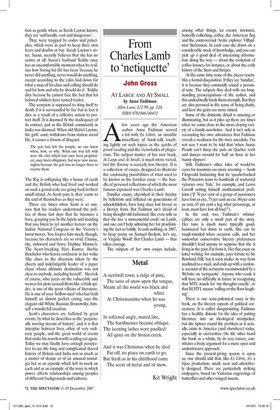From Charles Lamb to `netiquette'
John Gross AT LARGE AND AT SMALL by Anne Fadiman Allen Lane, £12.99, pp. 220, ISBN 9781846140433 Afew years ago the American author Anne Fadiman scored a hit with Ex Libris, an amiable miscellany of book-talk touching lightly on such topics as the quirks of proof-reading and the vicissitudes of plagiarism. The subject matter of her new book, At Large and At Small, is much more varied, but the flavour is scarcely less literary. It is a collection of essays, designed to illustrate the continuing possibilities of what used to be known as the familiar essay — the bundle of personal reflections of which the most famous exponent was Charles Lamb.
Familiar essays, cherished in their heyday by belletrists and inflicted on generations of schoolchildren, have long since lost favour as a literary form. But Fadiman isn't afraid of being thought old-fashioned. She even tells us that she has 'a monumental crush' on Lamb, and one can't help admiring her for proclaiming the fact so boldly. It costs nothing, in 2007, to heap praise on Samuel Beckett, let's say, or Virginia Woolf. But Charles Lamb — that takes courage.
The subjects of her own essays include, among other things, ice cream, insomnia, butterfly-collecting, coffee, the American flag and the controversial Arctic explorer Vilhjalmur Stefansson. In each case she draws on a considerable stock of knowledge, and you can pick up a good deal of interesting information along the way — about the evolution of coffee-houses, for instance, or about the early history of the Stars and Stripes.
At the same time none of the pieces resembles a formal disquisition. If they are `familiar', it is because they constantly sound a personal note. The subjects they deal with are longstanding preoccupations of the author, and this undoubtedly lends them strength. But they are also personal in the sense of being chatty, and here the gains are more mixed.
Some of the domestic detail is amusing or illuminating, but as it piles up there are times when we come close to the more cloying variety of a family newsletter. And it isn't only in recounting her own adventures that Fadiman reveals a weakness for the twee anecdote. I'm not sure I want to be told that 'when Annie Proulx can't sleep she puts on Quebec reels and dances around for half an hour in her bunny slippers'.
Still, Fadiman's other tales of would-be cures for insomnia are more arresting — Scott Fitzgerald fantasising that he 'quarterbacked the Princeton team to hundreds of nocturnal victories over Yale,' for example, and Lewis Carroll setting himself mathematical problems (If 70 per cent of a group of pensioners have lost an eye, 75 per cent an ear, 80 per cent an arm, 85 per cent a leg, what percentage, at least, must have lost all four?').
In the end, too, Fadiman's whimsicalities are only a small part of the story. Her tone is much more typically goodhumoured but down to earth. She can be tough-minded when occasion calls, and her somewhat conservative literary preferences shouldn't lead anyone to suppose that she is living in the past. Far from it. Her fine essay on letter-writing, for example, pays tribute to Sir Rowland Hill, but it soon makes its way from snailmail to e-mail, and ends up with a sardonic account of the acronyms recommended by a Website on `netiquette'. Anyone who reads it will have no difficulty in future in recognising that MTE stands for 'my thoughts exactly', or that ROTFL means 'rolling on the floor laughing'.
There is one semi-polemical essay in the book, on the literary aspects of political correctness. It is rather disappointing: Fadiman has a healthy distaste for the idea of putting literature into an ideological straitjacket, but she tiptoes round the problem as it actually exists in America (and elsewhere) today, especially in universities. On the other hand the book as a whole, by its very nature, constitutes a lively argument for a more open and undoctrinaire approach.
Since the present-giving season is upon us, one should add that, like Ex Libris, it's a bijou production, small, neat and attractively designed. There are particularly striking endpapers, based on Victorian engravings of butterflies and other winged insects.

































































































 Previous page
Previous page